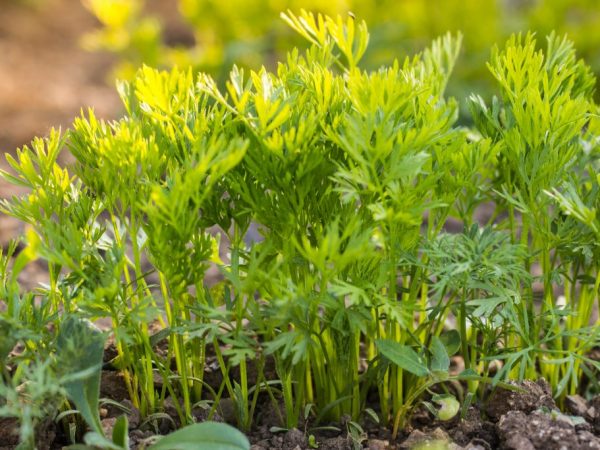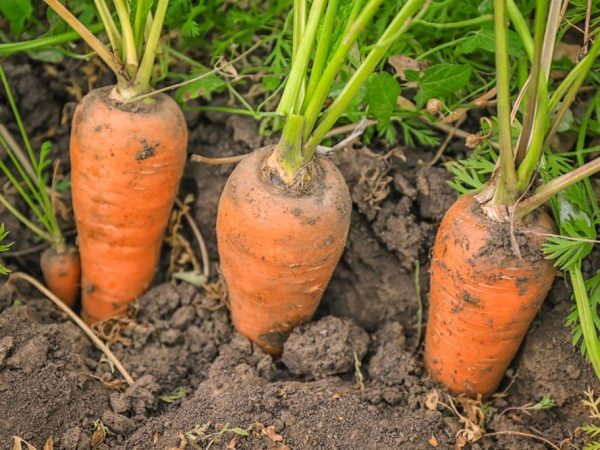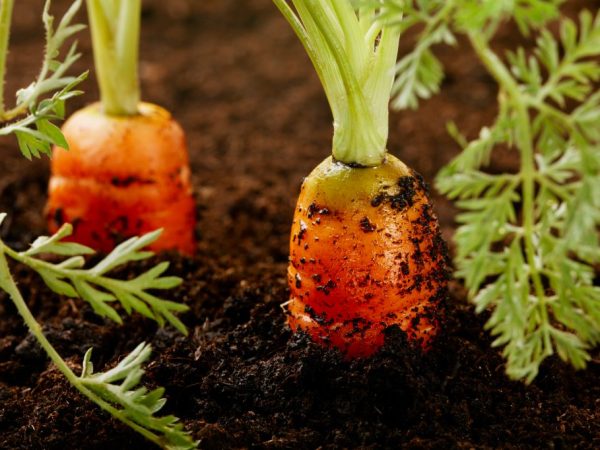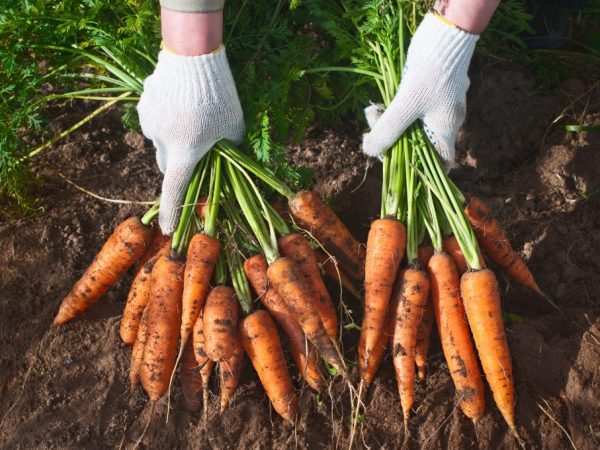Secrets of growing carrots
Growing carrots, which is one of the most common crops in our region, is possible even for a novice gardener. In order to achieve maximum yield and grow a juicy vegetable with a sweetish taste in the open field, a number of rules must be followed.

Secrets of growing carrots
Seat selection
Carrots need light and loose fertile soils that are good for moisture and air. The acidity of the soil should not exceed 7.
Fertility is increased by introducing humus. But it takes time for it to give all the nutrients to the soil. 1.5-2 years after the introduction of humus, the soil is enriched with nutrients and becomes suitable for growing vegetable crops that need a large amount of microelements. If garden crops are grown on the site every year, then humus is brought in annually.
To get a good harvest of carrots, they are planted in a well-lit area. Even a slight shade from a tree on the site will reduce Yield. The vegetable is planted in the place where garlic or onions, tomatoes, cabbage, cucumbers or potatoes were grown in the previous year.
Other crops, especially beets, are poor precursors for carrots. They are either affected by the same diseases as this vegetable, or they need the same trace elements as carrots. The most undesirable vegetable precursors are celery, parsnips, parsley, or dill.
It is impossible to plant a vegetable crop in the same place for more than 2 years: the soil becomes poor. In addition, it accumulates bacteria and spores of fungi that infect root crops.
The best time to plant carrots
To grow good carrots, you need to choose the right time to sow the seeds. This root crop is frost-resistant. In order for it to grow well, it must have a long daylight hours (12-14 hours).
Different varieties are planted at different times. In addition, climatic conditions in different regions differ significantly. In the Moscow region and the Leningrad region, for example, the climate is different, therefore, when choosing the time of planting, they are guided by the weather conditions:
- Early ripening hybrids are sown in open ground after its top layer is well warmed up. When deciding on the scale of the beds, they take into account that they have a short storage period.
- Mid-ripening and late-ripening hybrids are planted after the air temperature has risen above 15 ° C, and the soil has warmed up on the bayonet of a shovel. If sowed too early, they will not be as good as keeping quality. After the air temperature rises to 18 ° C-20 ° C, the soil becomes excessively dry. This negatively affects seed germination.
The type of soil also affects the planting time. When growing a root crop on light soils, planting is carried out throughout May.On medium soils, sowing seeds is carried out no later than the 2nd decade of May. When choosing a planting date, study the planting calendar for carrots by day.
When growing crops in a greenhouse or greenhouse, the planting dates are earlier. Growing carrots at home on a balcony or windowsill is not worth it. The root crop needs a large area.
With prolonged exposure of young plants to low temperatures (1 ° C-3 ° C), carrots bloom and begin to give arrows. It is impossible to prevent blooming after the carrots have released arrows. The culture is planted after establishing a stable air temperature of more than 15 ° C.
Preparation of planting material

Carrots are planted with seeds
The root crop is propagated by seeds. They are harvested from a plant at 2 years of age. It produces an umbrella-shaped inflorescence. The inflorescences are rich in essential oils that prevent moisture from reaching the embryo, which complicates the germination process.
The seeds are pre-soaked. This helps to discard low-quality ones, which rise to the surface of the water in 9-10 hours. After this time, the seeds are taken out of the water and laid out on a damp cotton cloth, kept at a temperature of 21-24 ° C for 2-4 days. Then the planting material is dried in a natural way.
If the seeds are not soaked, the first shoots will appear in at least a month. If this condition is met, the seeds will hatch after 10-12 days.
By soaking the seeds in hydrogen peroxide, it will be possible to simultaneously disinfect them. Before planting, some summer residents soak the seeds in a decoction of onion peels or pour them over with boiling water. These measures do not always give the desired result.
Sowing seeds in open ground
Before planting carrots on the selected bed, they are loosened to a depth of 15-20 cm. With the standard sowing scheme, seeds are sown in grooves made with a glanders. Their width should be 4-5 cm, and their depth should not exceed 2 cm. Recessed planting slows down the process of growing a vegetable crop. The optimal width between the beds is 20 cm.
The planting technology is simple. Seeds are spread at a distance of 2 cm from each other in prepared grooves. The soil inside the furrows is preliminarily moistened. Complicating the planting process is that the seeds are small.
Summer residents have secrets and tricks to simplify the process of sowing seeds.
- To avoid thickening of plantings, 1 tbsp. l. seeds are mixed with 1 tbsp. clean sand. This composition is enough to plant 3 square meters. m plot.
- In order not to start the beds in anticipation of the first shoots of the root crop, the carrot seeds are mixed with the seeds of lettuce or radish. These crops sprout much earlier. After their appearance, they begin to weed the area between the beds.
- Sowing is also simplified by gluing the seeds onto strips of tissue paper. The adhesive used is a paste made from wheat flour and potato starch.
- To avoid thinning with paste, glue 1 root seed and 1 fertilizer granule, placing them on a small paper square.
Carrots grow faster if covered with loose soil. Peat mixed with sand or earth is used as the top layer. The bottom layer of the ridges should be dense. They are watered after the first shoots appear. To make the moisture evaporate more slowly, mulch with peat.
Growing in beds and hydroponics
Mid-season and late varieties are best grown on ridges 22-25 cm high and 15-18 cm wide. This method of soil preparation is laborious, but it allows you to increase the yield of the crop. The root crop is also grown hydroponically. The culture bears fruit well, does not lag behind in growth, but gives small and short tasty fruits.
Vegetable crop care

It's very easy to keep track of carrots.
Caring for growing carrots involves loosening the soil, thinning seedlings, hilling, weeding and watering the site, applying fertilizers.
Weeding the soil
With a well-done marking of the planting, they begin to weed the area even before the first shoots appear. All weeds are removed by the roots. When growing carrots in the fields, one or another herbicide is used to control weeds. According to the instructions, chemical preparations do not have a negative effect on garden crops, but it is undesirable to use them in a country house or a small area near the house.
Soil loosening
Loosening of the soil is carried out on the second day after watering. No crust should form on the surface of the beds. If an earthen crust does appear, the soil is slightly moistened before loosening. If the crust has appeared even before the first shoots appear, loosening is done shallowly so as not to damage the planting material and not raise it to the soil surface.
Thinning the beds
Caring for sprouted carrots involves thinning the beds. The first thinning is carried out after 3-4 leaves have appeared on the plants, provided that the distance between them is less than 6 cm. Even at a distance of 5 cm, the root crop will not be able to grow normally. It is better to break through it after rain. If the time for thinning has come, and no rain is observed, the soil is pre-watered.
In order to break through the culture and not harm it, young plants are pulled out with an upward movement, and not to the side. The harvested plants are laid away from the garden: they attract harmful insects with a smell. Carrots are thinned in the evening, after the end of the procedure, the garden is watered.
Dive
A picking involves replanting plants. Diving carrots is undesirable: it begins to branch. This is due to the fact that during pulling the central root breaks off.
Hilling
Hilling a vegetable crop involves adding soil to the garden bed, after an insignificant part of the root crop has appeared above the ground. Under the influence of sunlight, the part that appears above the ground turns green, corned beef begins to stand out. This substance gives the vegetable a bitterness during long-term storage.
Carrots are spud on a cloudy day or closer to sunset. If you perform the procedure in sunny weather, you can attract a carrot fly to the beds. Light soils are used to cover the part of the root crop that has appeared above the ground.
Watering
It is impossible to grow good carrots without proper watering. It does not withstand both excessive moisture and drought. Most of all, the root crop needs watering during the period of active growth. If the weather is sunny and warm, the beds are watered no more than once every 2 days.
Watering young carrots is carried out at the rate of 4 liters per 1 sq. m. By the end of the active growth phase, the number of waterings is reduced to once a week. For 1 sq. m beds take 8-9 liters of water. If the weather is dry, the amount of watering is increased.
Fertilization
If the vegetable crop is planted on fertile soils, fertilizers are applied twice a season. Only late-ripening hybrids are fed three times. Most vegetable crops need potassium. She feels less need for phosphorus and nitrogen. Excess nitrogen leads to a weakening of the root system.
As fertilizers for the first top dressing, potash, nitrogen and phosphorus fertilizers are applied in the amount of 60 g, 50 g and 40 g, respectively. An alternative option involves the use of ammonium nitrate, superphosphate and potassium chloride in the amount of 20 g, 30 g and 30 g.
As a second feeding, nitrophoska is added (1 tbsp. L. Per 10 l of water), a solution of boric acid (1 tsp. Per 10 l of water) or wood ash diluted with water. At the third feeding of late-ripening hybrids, nitrogen-containing fertilizers are excluded.
Liquid top dressing is applied not under root crops, but in the aisles. In order for the root crop to acquire a moderate sweetness, it is treated with humates (1 g per 10 liters of water) 15-20 days before harvesting.
Harvesting

You can't always reach carrots with your hands.
It is bad when the root crop outgrows, but you should not pull it out in advance.At a temperature of 4 ° C, carrots stop growing, and at sub-zero temperatures, they are affected by gray rot. Harvested in late August or early September. As a rule, by the end of August, the root crop is fully ripe.
The ripening period of the culture is 80-115 days. There are early hybrids that mature in 2 months (Saturno F1). They are harvested in the middle of summer. The crop is stored in a bag that allows air to pass through well, or a box.
If the root crop has not passed all the phases of the growing season, and frost is imminent, you should independently accelerate the ripening period. There are growth stimulants on sale. The use of these biological products does not harm the vegetable crop.
The average plant yield is about 100 tons per hectare.
Pests and diseases
It is not enough to know how to grow carrots. It is important to be able to reanimate the beds and get rid of harmful insects, infections and viruses. Carrots are most susceptible to white and gray rot, bacteriosis, felt disease, and phomosis. Of the pests, vegetable crops are attacked by hogweed hogweed, carrot fly and hawthorn aphid.
- White rot appears due to excessive nitrogen in the soil. It will be possible to save the plants by introducing preparations containing copper.
- Gray mold is a fungal disease. Insecticides are used to treat carrots. As a preventive measure, soil disinfestation is carried out. Affected bushes look weak, the tops will wither even with sufficient moisture.
- Bacteriosis, or wet bacterial rot, is an infectious disease. Affected plants are removed from the garden, and phosphorus-potassium fertilizers are applied under the rest of the root crops. Affected plants are burned. If you bury them, the infection will penetrate the ground. Prevention of bacteriosis is timely loosening of the soil and compliance with the rules of crop rotation in the garden. To prevent the disease from affecting large and even carrots during storage, the harvest is dried in the sun after harvest.
- Rhizoctonia, or felt disease, is a fungal disease. As a fight against the disease, the plantings are sprayed with a solution that contains mancozeb or copper oxychloride. As a preventive measure, the rules of crop rotation are observed and the soil is periodically disinfected.
- Phomosis is one of the most dangerous fungal diseases. Affected plants are removed from the garden, the rest are treated with antifungal agents. As a prophylaxis for the disease, the crop is harvested on time and stored at a temperature not exceeding 10 ° C. The optimum storage temperature is 2 ° C. At lower temperatures, the root crop freezes, and at higher temperatures, it becomes lethargic. Sluggish carrots lose their taste. After harvesting, the carrot tops are removed from the site.
- To protect carrots from pests, flowers with a pungent smell are planted near the beds: marigolds, geraniums, etc. - they remove weeds in a timely manner and do not plant nearby vegetables that are affected by the same pests. Tar helps fight carrot onions.
To minimize the risk of any disease, high quality healthy planting material is used. Low-quality seeds often grow weak and light carrots, which during development often have to be treated with chemicals.
Conclusion
Carrots, with their high productivity, are a profitable crop. It is good for your health. For example, carrot juice drips into the nose with a runny nose. It is not always possible to grow even fruits. The reason for this is the introduction of chlorine-containing fertilizers, soil deacidification before sowing, the presence of organic matter in the ground, excess moisture, violation of the thinning process, excess nitrogen.
It is not necessary to acquire special equipment to grow large carrots and get a good harvest. The main thing is to take agrotechnical measures in a timely manner. This is helped by the technological map, where it is convenient to mark the watering time, the date of top dressing, etc., every day.
If the seeds are planted on different days, it is better to sign the beds. On the day of planting, it is easier to navigate the age of the plants. This information is important when applying top dressing and determining the date of harvest.
It doesn't matter if the carrots are frozen or frozen. The same dishes are prepared from frozen carrots as from fresh ones. But keeping rates under the influence of frost deteriorate, so they use it in the first place.


